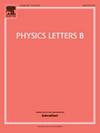Accretion of the degenerate Fermi gas onto a Reissner-Nordström black hole
IF 4.3
2区 物理与天体物理
Q1 ASTRONOMY & ASTROPHYSICS
引用次数: 0
Abstract
We extend the Rioseco and Sarbach model into Reissner-Nordström black hole accretes degenerate relativistic Fermi gas. The accretion theory is based on the Boyer-Lindquist coordinates and the Fermi gas follows Fermi-Dirac statistics at infinity. The expressions for the particle current density, the stress energy-momentum tensor, and three accretion rates are derived. We first investigated the impact of Risoseco and Sarbach model on the evolution of a black hole's charge. The results show that both the mass accretion rate and charge accretion rate are proportional to the particle accretion rate. We have also provided analytical results at infinity and numerical results within a finite range for these quantities. Our results indicate that the accretion rate decreases as the charge of the black hole increases, suggesting that our accretion model does not violate the cosmic censorship hypothesis. In this paper, we first point out that the accretion of Vlasov gas behaves as an anisotropic fluid containing two perfect-fluid components. One component represents the isotropic Fermi gas fluid, while the other represents a coordinate-dependent null fluid. When using the Boyer-Lindquist coordinate system, we observed that the contribution from the null fluid persists even at infinity, which led to the radial pressure always smaller than the tangential pressure.
简并费米气体向Reissner-Nordström黑洞的吸积
我们将Rioseco和Sarbach模型扩展到Reissner-Nordström黑洞吸积简并相对论费米气体。吸积理论基于Boyer-Lindquist坐标,而费米气体在无穷远处遵循费米-狄拉克统计。导出了粒子电流密度、应力能量动量张量和三种吸积速率的表达式。我们首先研究了Risoseco和Sarbach模型对黑洞电荷演化的影响。结果表明,质量吸积率和电荷吸积率均与粒子吸积率成正比。我们还提供了这些量在无穷远处的分析结果和有限范围内的数值结果。我们的结果表明,吸积速率随着黑洞电荷的增加而降低,这表明我们的吸积模型并不违反宇宙审查假说。本文首先指出Vlasov气体的吸积表现为一种各向异性流体,包含两个完全流体组分。一个分量表示各向同性费米气体流体,而另一个分量表示与坐标相关的零流体。当使用Boyer-Lindquist坐标系时,我们观察到零流体的贡献即使在无穷大时仍然存在,这导致径向压力始终小于切向压力。
本文章由计算机程序翻译,如有差异,请以英文原文为准。
求助全文
约1分钟内获得全文
求助全文
来源期刊

Physics Letters B
物理-物理:综合
CiteScore
9.10
自引率
6.80%
发文量
647
审稿时长
3 months
期刊介绍:
Physics Letters B ensures the rapid publication of important new results in particle physics, nuclear physics and cosmology. Specialized editors are responsible for contributions in experimental nuclear physics, theoretical nuclear physics, experimental high-energy physics, theoretical high-energy physics, and astrophysics.
 求助内容:
求助内容: 应助结果提醒方式:
应助结果提醒方式:


